I ended the previous post leaving you, the reader, waiting for something astonishing. It was this: Shortly after supper but before the train had chugged its way back to Darwin (Yes, I know, trains don’t actually chug anymore but chugging in is more entertaining than rolling into Darwin, don’t you think?) J announced that the RS crew (and I don’t know what level of coordination it entailed) had not only managed to arrange for our group to reach Alice Springs Thursday – albeit later than the train would have gotten us there – but that all 21 of us were on the same flight. Think about how fortunate we were to have a flight with 21 open seats. (And now, your suspense is ended.)
We spent the night on the train having received a note from Journey Beyond that included this information:
Tomorrow morning, we have arranged a cruise for all guests along the beautiful Darwin Harbour. You will then return to The Ghan for lunch onboard and an afternoon spent relaxing. At approximately 4.30pm (sic) you will be transferred to Darwin for your dinner hosted by Journey Beyond.
The cruise departed from Stokes Hill Wharf
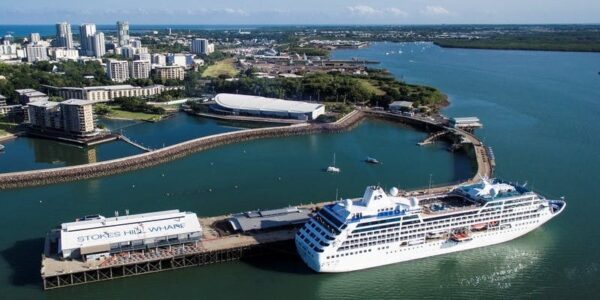
[From Aussie Bucket List]
which had been part of our Tuesday morning bus tour. And here’s a satellite view from Google maps of the harbor with Stokes Hill Wharf at the bottom.
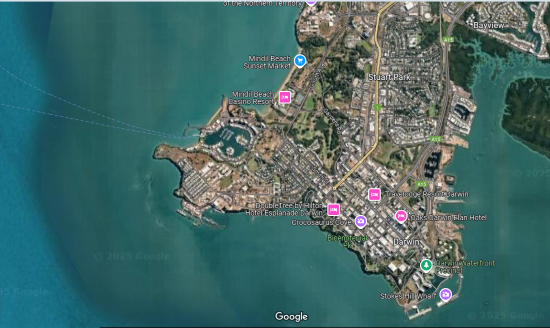
I’ll leave it to you to determine whether you think it beautiful. I’ll simply say, it’s not Sydney.
Because our RS team had been so efficient, those of us who were so inclined could take the harbor cruise but lunch would have to be more of a grab and go because we had to collect our luggage and get on the bus to the airport, check-in and board our 16:20 flight to Alice Springs.
I’d like to report that I learned a lot from our cruise but the person responsible for narrating the transit around the harbor reminded me a bit of M, our Sydney site coordinator. While it seemed to me that his comments were all relevant, he made temporal leaps that, if they connected in any sort of narrative arc, were beyond my ability to grasp and quickly lost my attention.
(To be fair, I think Journey Beyond – which also operates the harbor cruise we were on – must have called their crew in at the very last minute. They don’t seem to typically offer daytime cruises but rather provide either a dinner cruise or one called “Sunset Gaze and Graze” so he likely had very little notice, preparation, or training to provide this sort of narration.)
At one end of the cruise or the other, we has some free time and some in our group chose to visit the Royal Flying Doctor Service Tourist Facility. Since we were scheduled to visit the RFDS facility in Alice, I tried to find a shady spot to wait for our coach.
Stokes and Wickham – mainly Stokes
However, two names that must have come up repeatedly in his narration were Wickham and Stokes because they are mentioned in the contemporaneous notes I made so I looked them up that night. You might recognize the names John Clements Wickham and John Lort Stokes because they are the two shipmates of Charles Darwin who were instrumental in naming the harbor Port Darwin. (Credit for this is usually bestowed on Whickham because he was commanding the HMS Beagle when it sailed into the harbor though Stokes undoubtedly played a part in that decision.)
Stokes, a naval man who would retire as an admiral,
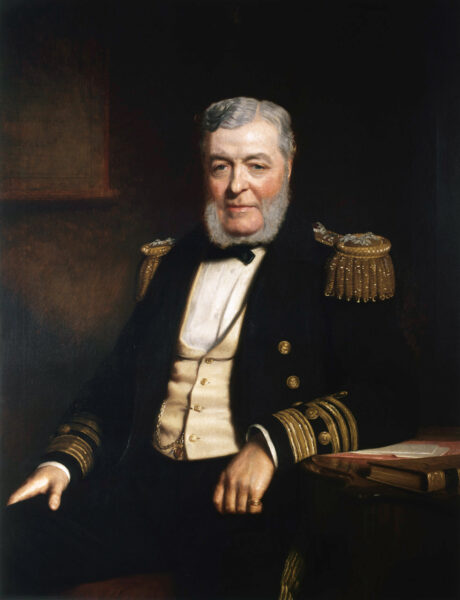
Admiral John Lort Stokes
by Stephen Pearce
[From Wikipedia – Public Domain]
didn’t limit his explorations and mapping expeditions to the coastal areas of either Australia or Aotearoa-New Zealand alone. He frequently went on inland expeditions. Although he is best known for his exploration and mapping of the coastal area of the Northern Territory and Western Australia, Stokes also explored in New South Wales, Queensland, and South Australia. In December 1839, on an expedition at Bookyana (today called Point Pearce) in Narungga Country
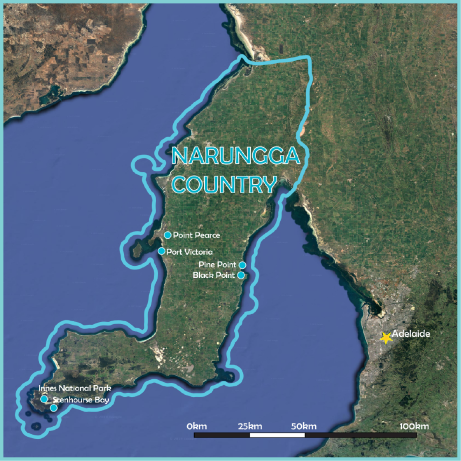
[From Aboriginal Coastal Tours SA]
at the area near Point Pearce, Stokes was speared by Aboriginal people probably of the Nurungga Clan.
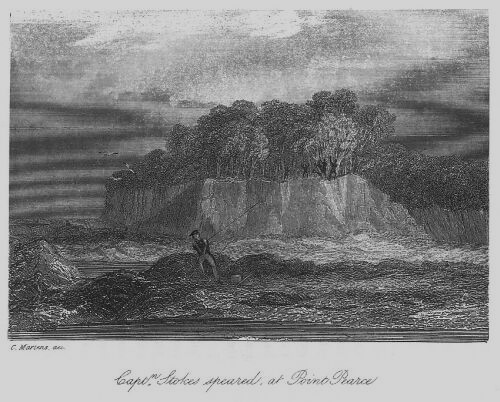
[From Project Gutenberg]
(It seems to me that he could have tried renaming the place Point Pierce but instead chose to call the location Treachery Bay – a name that doesn’t appear in that area on any maps I have found.)
Now I’m going to engage in a bit of speculation because it will serve as a segue to a topic I need to address. Recall that Adelaide was founded at the end of 1836 and that 355 people participated in the vote to settle the dispute between Light and Hindmarsh. Let’s assume there were women, children, and others who didn’t vote and that the city’s nascent population was between 500-600. The area did grow rapidly however as an 1840 census shows a population of 2000.
Stokes was exploring the area of Bookyana in 1839 so even with the relatively explosive growth of Adelaide some 200 kilometers distant, it’s unlikely that many Europeans had ventured into Narungga country. It’s possible that there had been some limited contact or that the Narungga People had learned to be wary of Europeans from other clans such as the Kaurna.
For purposes of argument, though, let’s also assume that, as Stokes saw things, the attack on him was unprovoked. Again this is possible but not in keeping with Aboriginal culture as I understand it. My speculation is that Stokes was not traveling through Narungga Country respectfully because he was unaware of the
Songlines.
Songlines are another essential element in the lives of Australia’s First People not merely as a part of their culture but as an expression of their connection to Country. Yes, songlines are songs but they are more than that. They are maps and, while they can be represented visually through art and it’s likely that an aboriginal person could read the map in the image below, they don’t need the image. Only the song.
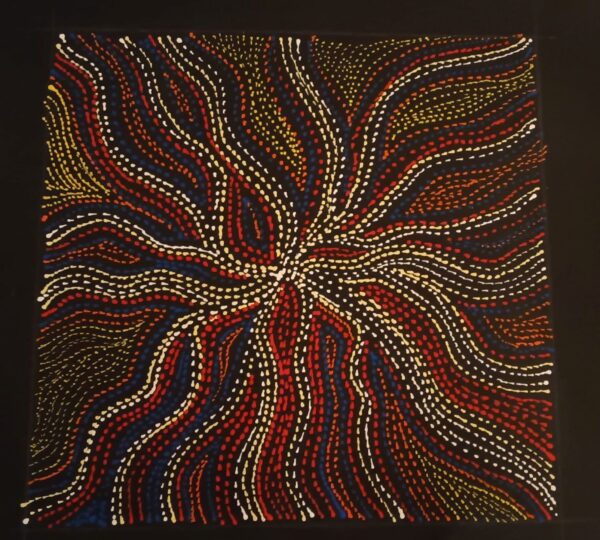
But they’re not only navigational maps of Country (and in this instance Country can sometimes signify the entire continent) but the songs carry metaphysical and cultural information that helps maintain a spiritual connection to the land.
(There are few better ways to transmit cultural information for people without writing systems. Rhythm, rhyme and melody become mnemonic devices. When combined with the emotional engagement people naturally have with music, it embeds the knowledge more deeply and allows for effective cross-generational transmission.)
Before Europeans arrived (and to a lesser degree still today), crossing into another group’s country required permission, and the hosting group would offer safe passage and spiritual protection to the visitor. Visitors were expected to respect the protocols and rules of the caretaker group. (The popularization of the term is usually attributed to Bruce Chatwin’s 1987 book of that name.)
In a traditional Welcome to Country, only a recognized elder or traditional caretaker will share information about safe places to travel. It will contain crucial information about the land, such as safe food sources, water locations, and areas to avoid including sacred sites. (Recall how the Jawoyn view certain Dreaming sites in Nitmiluk as needing to be approached with care or not disturbed at all.) Even when languages aren’t shared, elements within the song such as melody and rhythm are universally recognized.
It’s my personal hypothesis that Stokes entered Narungga Country not only without a proper Welcome to Country ceremony but that he trespassed in ways that prompted some measure of payback.
If you have 15 minutes or so, you can gain a deeper understanding of Songlines from this video.
Bush Tucker
(Familiar things are strange)
In addition to scrambling to arrange our flight, (and Alice Springs has an interesting baggage claim area)
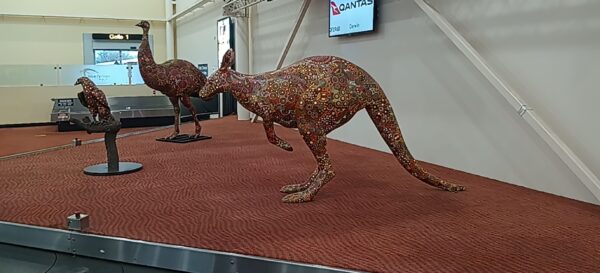
M, our RS site coordinator, had to rearrange our scheduled activities in Alice moving nearly everyone to Friday. One Alice experience that required only a slight modification was our Bushfoods dinner with a lecture by Rayleen Brown.
Rayleen is from Central Australia and is a First Nations business owner there whose specialty is working with Central Australian bush foods. She told us her personal history and how she came to start her business Kungas Can Cook while introducing us to an array of wild harvest bush tucker sourced directly from the women who gather the food. She does this not only to support their livelihoods but also as a continuation of connection to story and Country.
As her staff prepared our dinner, Rayleen stood in front of a table of Central Australian bush delicacies
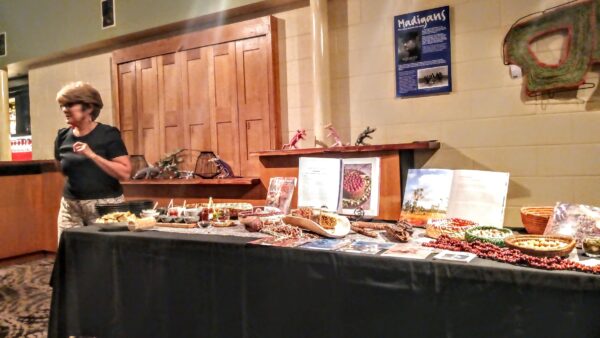
that included bush tomatoes, wattle see, pepper berry, and quandong among others. She’d prepared some rubs and chutneys for us to taste and it was all delicious. Road Scholar hit this one out of the park.
(You’ve seen both pictures from the day.) Tomorrow our group will explore not just A Town Like Alice but Alice itself.